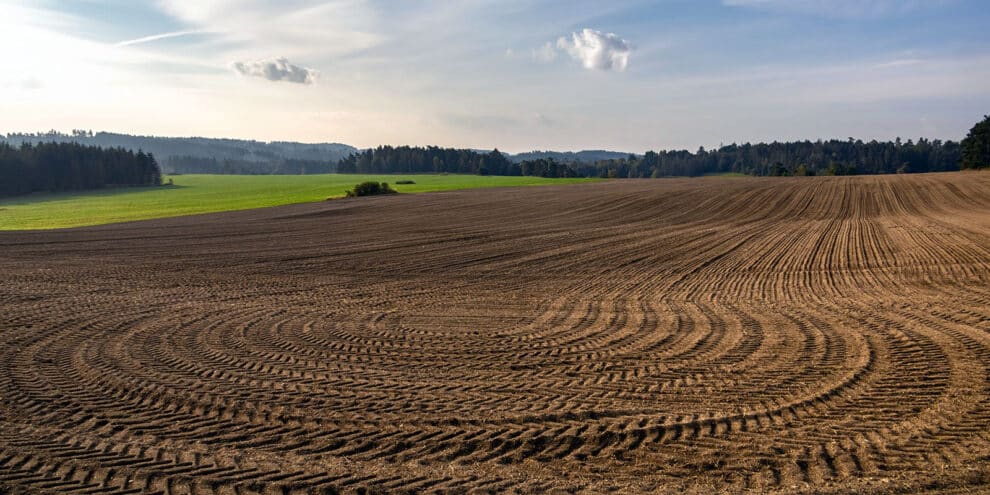Understanding the composition of soil is essential for making informed decisions about agricultural practices, promoting effective land management, and addressing the production of food and feed for a growing global population. Here, let’s briefly explore how soil texture, organic matter, pH, nutrients, and soil structure play a role in composition.
First, soil texture indicates the relative content of particles of various sizes, such as sand, silt and clay in the soil. Texture influences the soil’s physical properties, such as like grit, smoothness, stickiness, water-holding capacity, drainage, and aeration. The USDA’s Natural Resources Conservation Service provides a comprehensive guide on soil texture classification (1). Knowledge of soil texture helps determine suitable crops, irrigation strategies, and soil management practices. For example, sandy soils with low water-holding capacity may require more frequent irrigation and organic amendments to enhance their fertility (2).
Next, organic matter is an important component of soil composition, derived from decomposed plant and animal materials which typically makes up 1 to 5% of soil. Organic matter plays a vital role in soil fertility, structure, nutrient cycling, and microbial activity. It holds water, makes nutrients available, is resistant to erosion, and helps plants grow. Researchers (Lal, 2004) have highlighted the importance of maintaining and increasing organic matter content in soils to enhance productivity and sustainability (3). Practices such as cover cropping, composting, and reduced tillage promote organic matter accumulation in soils (4).
Soil pH is a measure of the acidity or alkalinity of the soil. It is an important indicator of soil health. It affects crop yields, crop suitability, and plant nutrient availability. Different crops have specific pH requirements for optimal nutrient uptake. Adjusting soil pH through amendments can improve crop productivity. A study by Schachtman and Shin (2007) highlights the importance of understanding soil pH in nutrient management (5). Soil testing laboratories and extension services provide guidance on soil pH testing and recommended amendments for specific crops and regions that will enhance crop production. I am not an expert but merely a land advisor. Extension agents are an incredibly helpful resource. They are the experts, and I would encourage you to reach out to your county Extension office for specific questions and/or information.
Next, let me mention nutrient composition. Soil nutrients are critical elements for plant growth and productivity. Macronutrients (nitrogen, phosphorus, and potassium) and micronutrients (iron, zinc, etc.) are essential for plant growth and development. Assessing nutrient composition through soil testing allows farmers to make informed decisions on fertilization strategies. Nutrient management plans based on soil testing help optimize nutrient application, reduce environmental impacts, and ensure sustainable agriculture. Research by Havlin et al. (2014) provides comprehensive insights into nutrient management principles (6).
Finally, soil structure is the architecture of the soil. Soil structure refers to the way soil particles group together to form aggregates, influencing root growth, water movement, and aeration. Well-structured soils promote root penetration, enhance water infiltration, and prevent erosion. Soil compaction, organic matter content, and biological activity significantly impact soil structure. Practices such as conservation tillage or no-till gardening to avoid soil compaction, will help maintain or improve soil structure. Lal (2015) emphasizes the importance of soil structure in sustainable land management (7).
In the end, understanding the composition of soil is central to achieving long-term agricultural sustainability. By considering soil texture, organic matter content, pH level, nutrient composition, and soil structure, farmers and land managers can make informed decisions to improve soil quality, enhance farm productivity, and preserve the environment. Soil composition and soil health are key to biodiversity and food security, it’s thereby an essential ingredient for achievement promoting a sustainable future for generations to come. By applying scientific knowledge to soil composition, we can ensure the wise stewardship of this valuable resource.
Invest. Grow. Conserve.
References:
1. USDA-NRCS. (n.d.). Soil Texture. Retrieved from https://www.nrcs.usda.gov/wps/portal/nrcs/detail/soils/edu/?cid=nrcs142p2_054311
2. Brady, N.C., Weil, R.R. (2016). The Nature and Properties of Soils. Pearson.
3. Lal, R. (2004). Soil carbon sequestration to mitigate climate change. Geoderma, 123(1-2), 1-22.
4. Blanco-Canqui, H., Lal, R. (2009). Crop residue removal impacts on soil productivity and environmental quality. Critical Reviews in Plant Sciences, 28(3), 139-163.
5. Schachtman, D.P., Shin, R. (2007). Nutrient sensing and signaling: NPKS. Annual Review of Plant Biology, 58, 47-69.
6. Havlin, J.L., et al. (2014). Soil Fertility and Fertilizers: An Introduction to Nutrient Management. Pearson.
7. Lal, R. (2015). Soil health and carbon management. Food and Energy Security, 4(2), 117-126.
This content may not be used or reproduced in any manner whatsoever, in part or in whole, without written permission of LANDTHINK. Use of this content without permission is a violation of federal copyright law. The articles, posts, comments, opinions and information provided by LANDTHINK are for informational and research purposes only and DOES NOT substitute or coincide with the advice of an attorney, accountant, real estate broker or any other licensed real estate professional. LANDTHINK strongly advises visitors and readers to seek their own professional guidance and advice related to buying, investing in or selling real estate.










Add Comment